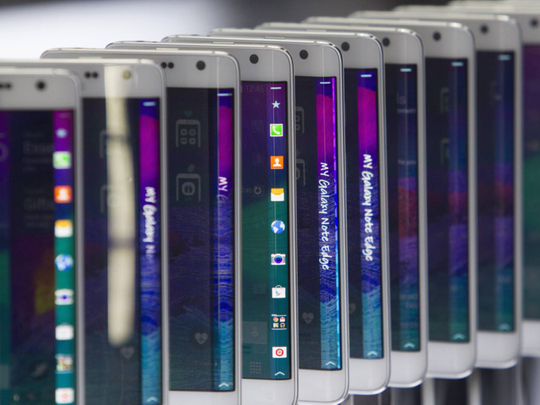
The smartphone market is set for lots of changes this year, but big, category-changing innovations are unlikely, according to telecoms executives who have knowledge of this year’s launch plans.
Chinese smartphone makers are expected to achieve mainstream acceptance across developed western markets this year, forcing rivals to lower their prices.
Pleasingly for consumers — but perhaps worrying for manufacturers such as Samsung — the key trend will be to offer much more technology for much less money.
Yet the world’s largest smartphone makers who may struggle compete on price are looking to new materials, faster processors and sharper cameras to retain and attract customers.
Other technology groups will focus on making wearables smarter and more fashionable — including the first wrist-worn device expected from HTC — with more watches expected that can be used without having to buy a phone. But smartphones are as smart as they are likely to be for some time, warned one executive, which means price will become the key battleground for many manufacturers in an increasingly commoditised technology sector.
Platforms
Smartphone manufacturers relying on Google’s Android software will race to be first to use Lollipop, the latest update of its operating system.
China’s OnePlus One and Elephone and India’s Karbonn will become better established in major markets alongside Asian rivals such as Huawei, Xiaomi and Lenovo. These companies will challenge premium smartphone makers such as Sony and Samsung with similarly advanced Android devices at low prices.
Established groups are far from finished, however. Sony is set to trim its range of smartphones, a move welcomed by mobile operators. Apple’s attentions are expected to focus on its forthcoming smartwatch, according to one mobile operator executive. It will also try to use the move to smart homes and health care services to broaden the appeal of its platform beyond hardware.
Microsoft is also expected to target Android phonemakers at the lower end of the smartphone market with cut-price Windows Phones in 2015 — a strategy that started last week with the release of its cheapest Lumia device to date at about 69 euros. Telecoms experts also believe Microsoft will more closely align its various devices — PCs using Windows 10, smartphones on Windows Phone 10 and the Xbox games machine — which will allow it to offer a more fully rounded ecosystem akin to that of Apple.
Chips
The use of octa-core and 64-bit chips in phones — used in Apple’s latest range of iPhones to increase the computing power — is expected to become more commonplace.
This will enable much faster processing from many of the cheaper phones coming to market. Customers will be able to get their hands on a device with a comparable processing of a top-end 2014 Android phone for less than half of this year’s price, executives said. Using 4G chips to deliver higher speed mobile broadband will also become the norm.
Cheaper chipsets in particular from Taiwan’s MediaTek will keep a lid on prices. “Its back to the days of the PC when the entry of Chinese and Taiwanese firms meant a commoditisation of devices offering phenomenal performance for low prices,” said one executive.
Materials and design
Materials will be where some premium smartphone makers try to stand out, with Samsung and HTC said to be moving from plastic cases to more solid metal and glass (such as the next generation Gorilla Glass 4 that will be used in launches this year).
The ongoing race to provide the world’s thinnest smartphone will recommence, but sales will remain relatively small given that such devices sacrifice battery life and features. Larger smartphones are here to stay, however, in part because of the popularity of Apple’s iPhone 6 series.
Expect more big screens produced by slimming down the bezel around the screen, rather than increasingly the size of overall device.
Cameras and batteries
Manufacturers will continue to use camera quality to differentiate their products, with front-facing cameras set to be improved to meet the demand for quality “selfies”.
HTC is expected to produce more “ultra-pixel”, wide-angle, front-facing cameras, while most phonemakers will improve rear-facing cameras with ever higher numbers of mega pixels. Analysts at CCS Insight also expect 3D and multiple array cameras to appear in flagship smartphones, which will provide enhanced photography capabilities such as focus changing and measuring heights and distances.
Battery life will also continue to improve, and Motorola in particular is expected to stress its phones are among the best for battery technology.
Wearables
The biggest opportunity — and potential risk — for many smartphone makers is wearables. Apple’s launch of a watch is hoped to push a still niche market to the mainstream — but the rapid introduction of low-cost alternatives from Asian manufacturers could mean that few will make much profit.
Many executives thought that HTC’s first wearable would be significant for the premium-priced segment. But this market will also be led by fashion, with more watch brands set to launch connected devices. The telecoms experts believed that round-faced watches — such as those from LG and Moto — would remain the most popular this year.
The lower end of the market will be dominated by fitness and wellness bands — with health care apps growing on the back of GPS and other sensors within wearable devices. However, consumers will again be able to buy much of the power and function of a top-priced Jawbone or Fitbit for less from Asian manufacturers attracted to the market by low entry barriers.
— Financial Times












